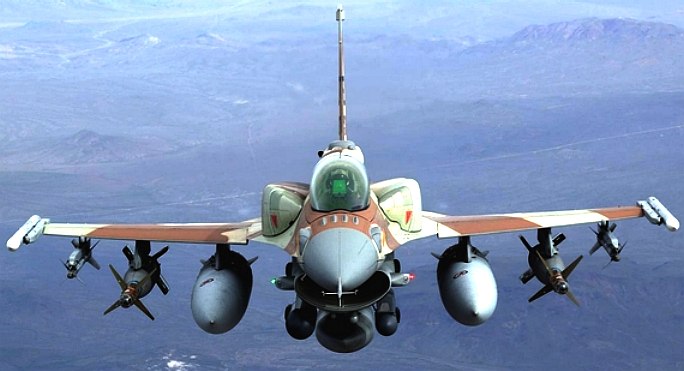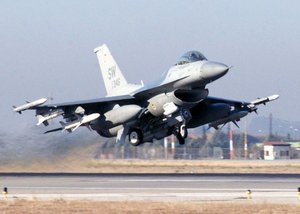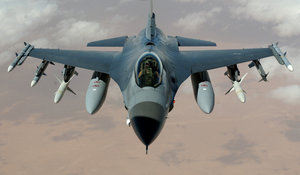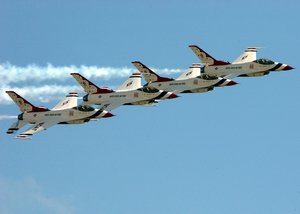|
LOCKHEED MARTIN F16 FALCON
|
|||
|
The Lockheed Martin F-16 Fighting Falcon is a compact, multirole fighter aircraft. It is highly maneuverable and has proven itself in air-to-air combat and air-to-surface attack. It provides a relatively low-cost, high-performance weapon system for the United States and allied nations.
The F-16 Fighting Falcon is a modern multi-role jet fighter aircraft built in the United States. Designed as a lightweight fighter, it evolved into a successful multi-role aircraft. The F-16 was developed by General Dynamics. In 1993 General Dynamics sold its aircraft manufacturing business to the Lockheed Corporation, now Lockheed Martin. The Falcon's versatility is a paramount reason it was a success on the export market, and is serving 24 countries. It is the largest and probably most significant Western fighter program, with over 4000 aircraft built. Though no longer produced for the United States Air Force, it is still produced for export.
The Fighting Falcon is regarded as a superb dogfighter, with innovations such as the bubble canopy, side-mounted control stick, and reclined seat. It was also the first US fighter aircraft to match the English Electric Lightning's ability to execute 9 g (88 m/s²) turns. Although the F-16's official popular name is "Fighting Falcon," it is well-known as the "Viper," the General Dynamics codename for the project during its early development.
HISTORY
Development
The F-16 originates in a set of specifications the United States Department of Defense issued in 1974. The deficiencies of the F-4 Phantom II in aerial combat in the Vietnam War, particularly at close ranges, shaped the specifications for the F-15. An informal and influential group nicknamed the "Fighter Mafia", among them systems analyst Pierre Sprey, test pilot Charles E. Meyers, and instructor pilot John Boyd, believed the F-15 was a move in the wrong direction. They argued that the F-15 was too large and expensive. Designed as a fast interceptor, it had a wide turn radius and was not well suited to close range dogfighting. The Fighter Mafia argued for a lighter fighter with superb maneuverability, that was cheap enough to deploy in numbers. These specifications became the Lightweight Fighter (LWF) program, begun in 1971.
The LWF specified a plane weighing 20,000 pounds (9,000 kg), half the weight of the F-15, stressing low cost, small size, range, and emphasising maneuverability — turn rate and acceleration — at the expense of top speed. Its ideal operating environment was intended to be under Mach 1.6 and 40,000 feet (12,000 m). Two companies were chosen during the concept stage: General Dynamics with the YF-16 design and Northrop with a design which bore the name YF-17 Cobra.
The LWF faced significant opposition in the Air Force because it was seen as competition to the F-15, the Air Force's premier fighter program. To head off opposition the project was redesignated Air Combat Fighter (ACF). At this time, Belgium, Denmark, the Netherlands, and Norway were seeking a replacement for their F-104 Starfighters, and formed the Multinational Fighter Program Group to choose a replacement. Both ACF aircraft were in consideration, as well as the Dassault Mirage F1 and the Saab Viggen. Also during this time, the Navy was looking for a low-cost alternative to the F-14 Tomcat, a similarly expensive, costly interceptor as the F-15, in a program called VFAX. Congress directed the Navy to use the same aircraft as the ACF programme. As the VFAX was envisioned to be a multi-role aircraft, this requirement made it into the ACF specifications as well, staving off direct competition with the F-15 as it was pitched to be a counterpart.
On January 13, 1975, the Air Force chose the YF-16 as the winner of the ACF competition as it gave superior performances across the board and promised to be cheaper to procure and maintain. It used the same engine as the F-15, which F-15 supporters believed would help their program. There were also political concerns with keeping General Dynamics in business after the end of the F-111 program. The US Navy chose to have the YF-17 design developed into the F/A-18 because it offered twin-engined reliability, then viewed as essential for over-water operations.
The plane was offered to NATO members, and made an appearance at the 1975 Paris Air Show. The MFPG nations agreed to purchase 348 planes, with final assembly to take place in Belgium and various parts subcontracted among them.
F -16 C/J Fighting Falcon
Production
Initially, the F-16 was manufactured in two models: A (single-seat combat version) and B (combat-capable two-seat trainer). The F-16A first took flight in December 1976 and was first delivered to the 388th Tactical Fighter Wing in January 1979. In the same month, they were delivered to the Belgian Air Force. The F-16 is the first American fighter to be concurrently deployed domestically and abroad. The B model is a trainer version with an extended canopy to accommodate a second pilot, also reducing fuel and avionics growth space. Typically the student pilot sits in the front cockpit with the instructor pilot behind.
In the 1980s, the F-16A/B was superseded by the F-16C/D with improved avionics and engine. The F-16 has been continually upgraded throughout its production history; block designations reflect significant upgrades and are outlined below. The empty weight of F-16 grew from 15,600 pounds (Block 10 F-16A) to 19,200 (Block 50 F-16C).
Due to their ubiquity, the F-16s have participated in numerous conflicts, most of them in the Middle East. In 1981, 4 Israeli F-16s participated in a raid that destroyed Osiraq, an Iraqi nuclear reactor near Baghdad. The following year, during the invasion into Lebanon, Israeli F-16s engaged on numerous occasions with Syrian aircraft, ending up victorious at all times but one. F-16s were also used afterwards in their ground-attack role for strikes against targets in Lebanon. In the Gulf War of 1991, F-16 from the air forces of the Coalition participated in the strikes against Iraq.
The
Air Force now operates Block 40/42 and 50/52 F-16C's on active
duty, while Block 25 and 30/32 airframes have been moved to the Air
National Guard. The
F-35
"Joint Strike Fighter" is the F-16's intended
replacement, possessing slightly improved performance and most
importantly, stealth technology, which will enhance its
survivability in the modern battlespace.
F -16 C/J Fighting Falcon
Design characteristics
The F-16 is a single engine, multi-mission tactical aircraft. It is equipped with built-in M61 Vulcan cannon, and can be equipped with air-to-air missiles. However, the F-16 can also perform ground-support tasks if necessary. For that task, it can be equipped with a large variety of missiles or bombs.
From the very beginning, the F-16 was intended to be a cost-effective "workhorse," that could perform various kinds of missions and maintain around-the-clock readiness. It is much simpler and lighter than its predecessors, but uses advanced aerodynamics and avionics (including the first use of fly-by-wire, earning it the nickname of "the electric jet") to maintain good performance.
Ergonomics and visibility
The pilot sits high in the fuselage with the canopy support-bow behind him, out of his line of view. This and the bubble canopy give the pilot optimal visibility, a feature vital during air-to-air combat. The seat is reclined 30 degrees instead of the usual 13, to aid in dealing with G-forces. The control stick is mounted on the right armrest rather than between the legs as is traditional, to aid in maneuvering during high-g turns. In addition, a holographic Head-Up Display displayed vital information in the pilot's field of view.
Fly by wire
The F-16 is an aircraft without direct linkages from the pilot's controls to the plane's control surfaces. Instead, his control inputs are translated to digital input to computers (quadruple redundant on the F-16) which then interpret the optimal control changes to implement those directions. This is known as a fly-by-wire system. It is faster to respond, more efficient (as it automatically utilizes all control surfaces, enabling the elimination of unwanted side effects like sideslip), and can result in a smoother flight as the computer can respond to external conditions faster than a human can. More importantly, coupled with input from the flight instruments, the computer can keep an inherently unstable aircraft in stable flight through continuous tweaks to the control surfaces. This enables the the F-16 to fly in spite of its negative stability.
Negative stability
An aircraft with negative stability will, in the absence of control input, depart from level and controlled flight. Aircraft are typically designed with positive stability, where a plane tends to move towards level flight in the absence of control input. However, positive stability hampers maneuverability, as the tendency to enter level flight interferes with flight maneuvers, and so a plane with negative stability will be more maneuverable. With a fly-by-wire system, such a plane can be kept in stable flight, its instability kept in check by the flight computers.
The YF-16 was the world's first aircraft to be aerodynamically unstable by design. The aeroplane is constantly on the verge of flipping up or down totally out of control. This tendency is constantly caught and corrected by the fly-by-wire control system, so quickly that neither the pilot nor an outside observer could know anything was happening.
USAF Thunderbirds perform an echelon pass flying 18 - 24 inches apart at 400 mph
Versions
F-16 models are denoted by sequential block numbers to denote significant upgrades. The blocks cover both single and two-seater versions. An intricate Multinational Staged Improvement Program was instituted to gradually upgrade the F-16 and retroactively implement the upgrades in delivered aircraft.
F-16 A/B
The F-16 A/B was initially equipped with the Westinghouse AN/APG-66 Pulse-Doppler radar, Pratt & Whitney F100-PW-200 turbofan, rated at 14,670 lbf (64.9 kN), 23,830 lbf (106.0 kN) with afterburner. The USAF bought 674 F-16A's and 121 F-16B's, with delivery completed in March 1985.
F-16 C/D
F-16 E/F
Other variants
Operators
Main article: Operators of the F-16 Fighting Falcon Total delivered or on order as of 2005:
Current sale proposal by the USA
Recent discussion with the Indian ministry of defence indicates that the F-16 could be bought by the Indian Air Force. The United States government has also expressed interest in the co-production of F-16s in India. This development will tremendously increase the significance of the F-16s in the South Asian power equation. However, Russia has threatened that if India moves away from the Russian market then Russia will open its military aviation market to India's foe Pakistan. Pakistan is interested in buying Russian Sukhoi Su-35 aircraft. India currently uses Russian MiG-21, MiG-27, and MiG-29 aircraft as well as the Sukhoi Su-30MKI, which has created the imbalance in air power in South Asia. The USA has also lifted curbs on Pakistan acquiring the latest F-16 block 52/52+ C/D version. Pakistan has indicated interest in buying over fifty-five F-16 Fighters. Pakistan is also looking into other fighters equal or superior to the F-16 — for example, Sweden's JAS-39 Gripen and France's Rafale.
Manufacturers
Specifications (F-16)
General characteristics
Performance
Armament
FilmsThe F-16 can be seen in the 1983 film Blue Thunder, 1985 Jewel of The Nile, 1986 Iron Eagle, 2002 The Sum of All Fears, and Independence Day.
AVIATION A - Z
A taste for adventure capitalists
When a state of the art submarine falls into extremist hands John Storm is called in to disarm the renegade craft.
|
|||
|
This website is Copyright © 1999 & 2012 Max Energy Limited an educational charity working hard for world peace. The bird logos and names Solar Navigator, Blueplanet Ecostar and Utopia Tristar are trademarks. All rights reserved. All other trademarks are hereby acknowledged. |
|||
|
AUTOMOTIVE | BLUEPLANET BE3 | ELECTRIC CARS | ELECTRIC CYCLES | SOLAR CARS | SOLARNAVIGATOR | UTOPIA |



